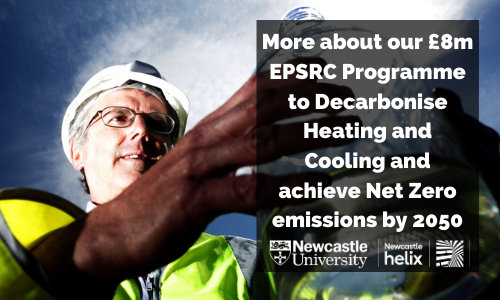Fracking is over in the UK. What have we learnt?
7 August 2020 | By: Richard Davies | 6 min read
It seems fracking to extract gas from shale in the UK is nigh-on dead.
This news follows the weakening of gas prices caused by Covid-191, and the comment made by the UK Energy Minister, Kwasi Kwarteng when speaking on the BBC in June that the ‘government has moved on’.
Over the last two years, we have worked with more than 60 other researchers across the UK towards the delivery of the Unconventional Hydrocarbons in the UK Energy System Programme. This programme is progressive in its delivery of integrated social sciences and natural sciences to provide the scientific-evidence base to enable decisions to be made about shale gas extraction in the UK.
So, what have we learnt from our research - including geoscience, environmental science and socio-economic? What's happened in the UK, which is critical for achieving Net Zero emissions and a green post-Covid-19 recovery?
The 2011 and 2019 moratoria on fracking in the UK both came about after induced seismicity occurred during and following fracking operations in Lancashire. Despite the intense monitoring and much research, scientists cannot yet predict, with sufficient accuracy, when, where and how much energy will be released by induced seismicity caused by fracking.2
Does this inability to accurately predict effects of hydraulic fracturing impact the future use of the subsurface? And does the way in which we communicate the risks and uncertainties of the use of subsurface impact its future use?
To this end, part of our Programme’s research has focused on understanding local people’s experiences of shale gas exploration in the UK and our learnings should frame the communication of future uses of, and activities in, the subsurface.
The UKUH research is set against the backdrop of a prominent role that the subsurface has to play in meeting the ambitious target to reduce our emissions to Net Zero by 2050 (as set by the UK government in June 2019).
The Climate Change Committee (CCC) Net Zero report3 indicated that the subsurface of the UK will have a critically important role in delivering Net Zero for storing or disposing CO2, which will be ‘a necessity not an option’. It is also worth noting that all pathways modelled by the Intergovernmental Panel on Climate Change (IPCC) that limit global warming to 1.5oC rely on CO2 removal at a very large scale (100-1000GtCO2) over the 21st century4.
If we did decide that CO2 storage is something that we must do, then we have plenty of subsurface storage capacity – could the UK become an export market to be used by other countries?
The UK Storage Appraisal Project (UKSAP) estimated a theoretical storage capacity of CO2 for the UK of 78 GT (at 50% confidence.)5
This is equivalent to ~200 years of the UK’s emissions at current rates, based on 2018 CO2 emissions, which were 366 Mt (excluding other GHGs).6
But CO2 storage underground, which is widely seen as one of the technical solutions to climate change, is not without risk: CO2 could leak, there is potential for CO2 injection to cause induced seismicity7, and other environmental impacts8,9,10.
The CCC also recommends a shift to a hydrogen economy11. Currently, production of hydrogen is by methane cracking or methane steam reforming, which both lead to greenhouse gas emissions12. Blue hydrogen would use the same process of steam-methane reforming but capture the carbon emissions through accompanying CCS. This method of hydrogen production will still require an adequate feedstock of natural gas. Furthermore, renewable sources of heat and transport could rely on hydrogen. Therefore, underground storage of H2 will be critical in order to meet demand and address seasonal variation between renewable energy generation and use. Currently very little is known about how hydrogen migrates and is trapped in the subsurface13. Therefore, it is crucial that research is carried out to understand the geological and environmental risks in addition to the socio-economic implications if we are to scale up H2 storage onshore the UK.
Potential of Geothermal Energy
We also have reasonable opportunity for deep geothermal energy production in the UK. Geothermal energy resources in the UK are estimated to be sufficient to deliver about 100 years of heat supply for the UK at present consumption rates14.
Currently, approximately 85% of homes in the UK use natural gas as fuel for their heating systems15 and given the need to decarbonise quickly to meet Net Zero emissions by 2050, there is an opportunity for heat to be extracted from below ground and used to heat homes. Furthermore, in some areas of the UK, exploitation of deep geothermal has potential for electricity generation, for example, the United Downs Project near Redruth, Cornwall aims to demonstrate the technical and commercial viability to produce up to 3MW electricity from the Cornish geothermal resource.16
The UKUH’s observations and analyses of the reactions caused when water is pumped kilometres underground to artificially create pathways in the rock and increase its permeability, have the potential to help inform the scientific-evidence base if we were to use the same rocks hundreds and thousands of metres beneath our feet for the sequestration of CO2, hydrogen storage, or for producing (geothermal)
hot water to heat towns and cities, e.g. Kettlety et al., 202017
We could even use the boreholes drilled by the oil and gas industry to do this, thereby taking advantage of the huge investment already made. Therefore, a win-win, putting to good use already installed infrastructure to support a post-Covid-19 green recovery.
But how will communities feel about injecting H2 in porous rocks for energy storage or CO2 for disposal rather than injecting fluids at high pressure to extract CH4, if the earth scientists, could not fully rule out seismicity, or seepage of pollutants in 100 to 1000 or 10000 years?
Likewise, the injection of CO2 could also cause seismicity because just like in fracking it has the potential to lubricate faults.
Researchers involved in UKUH are leading research into CCS risks and impacts18 and although H2 and natural gas have both been stored in salt caverns in the UK and elsewhere without arising the same challenges and controversy that fracking has, research is needed to address the environmental and social impacts of energy storage in the subsurface.19
Lessons from Fracking
There are many lessons from fracking. Firstly, even with the intense monitoring and most up-to-date technology and science, we cannot predict exactly what will happen when we pump fluid underground at high pressure.
Fracking is designed to physically modify the rock, and this can cause nearby faults to move leading to induced seismicity, but answering the questions ‘when?’, ‘how big?’ and ‘where?’ with acceptable confidence currently remains beyond us. Earth Scientists cannot provide cast iron guarantees of there being no felt seismicity.
Also, in contrast to Covid-19, the scientific communication around fracking has often been inadequate, lacking nuance and in some cases flawed.20
For example, the cartoons or graphics used to illustrate fracking are often completely unrepresentative, with giant fractures appearing to extend from several kilometres depth to pierce the countryside or reach schools and houses.
There is vast opportunity for post-Covid-19 green recovery jobs for clean growth and achieving Net Zero. The layers of rock beneath our feet can be part of the solution and we can put the old fossil fuel infrastructure to good use. But we must heed the lessons from fracking otherwise one of the most important UK assets in tackling climate change will be out of bounds.
The Authors
- Richard Davies, Newcastle University, UK
- Rachel Brown, Newcastle University, UK
- Mark Ireland, Newcastle University, UK
- Rob Ward, BGS, Keyworth
- Laurence Stamford, Manchester University
Related Pages and Links
- Newcastle University Centre for Energy
- Harnessing the heat beneath our feet to transition to Net Zero Emissions
- Unconventional Hydrocarbons in the UK Energy System
References
- IEA (2020), Gas 2020, IEA, Paris https://www.iea.org/reports/gas-2020
- Clarke, H., Verdon, J.P., Kettlety, T., Baird, A.F. and Kendall, J.M., 2019. Real‐time imaging, forecasting, and management of human‐induced seismicity at Preston New Road, Lancashire, England. Seismological Research Letters, 90(5), pp.1902-1915.
- The CCC, 2019. The UK’s contribution to stopping global warming. Committee on Climate Change: London, UK.
- Masson-Delmotte, T.W.V., Zhai, P., Pörtner, H.O., Roberts, D., Skea, J., Shukla, P.R., Pirani, A., Moufouma-Okia, W., Péan, C., Pidcock, R. and Connors, S., 2018. IPCC, 2018: Summary for Policymakers. In: Global warming of 1.5 C. An IPCC Special Report on the impacts of global warming of 1.5 C above pre-industrial levels and related global greenhouse gas emission pathways, in the context of strengthening the global. World Meteorological Organization, Geneva, Tech. Rep.
- Bentham, M., Mallows, T., Lowndes, J. and Green, A., 2014. CO2 STORage evaluation database (CO2 Stored). The UK's online storage atlas. Energy Procedia, 63, pp.5103-5113.
- https://assets.publishing.service.gov.uk/government/uploads/system/uploads/attachment_data/file/863325/2018-final-emissions-statistics-summary.pdf
- Kettlety, T., Verdon, J.P., Werner, M.J. and Kendall, J.M., 2020. Stress transfer from opening hydraulic fractures controls the distribution of induced seismicity. Journal of Geophysical Research:Solid Earth, 125(1), p.e2019JB018794.
- Paluszny, A., Graham, C.C., Daniels, K.A., Tsaparli, V., Xenias, D., Salimzadeh, S., Whitmarsh, L., Harrington, J.F. and Zimmerman, R.W., 2020. Caprock integrity and public perception studies of carbon storage in depleted hydrocarbon reservoirs. International Journal of Greenhouse Gas Control, 98, p.103057.
- Blackford, J., Alendal, G., Avlesen, H., Brereton, A., Cazenave, P.W., Chen, B., Dewar, M., Holt, J. and Phelps, J., 2020. Impact and detectability of hypothetical CCS offshore seep scenarios as an aid to storage assurance and risk assessment. International Journal of Greenhouse Gas Control, 95, p.102949.
- Damen, K., Faaij, A. and Turkenburg, W., 2006. Health, safety and environmental risks of underground CO 2 storage–overview of mechanisms and current knowledge. Climatic Change, 74(1-3), pp.289-318.
- Hydrogen in a low-carbon economy, The Committee on Climate Change, November 2018
- Weger, L., Abánades, A. and Butler, T., 2017. Methane cracking as a bridge technology to the hydrogen economy. international journal of hydrogen energy, 42(1), pp.720-731.
- McMahon, C.J., Roberts, J.J., Johnson, G., Shipton, Z.K. and Edlmann, K., 2020, May. Geological Storage of Hydrogen: Learning from natural analogues. In EGU General Assembly Conference Abstracts (p. 18548).
- Gluyas, J.G., Adams, C.A., Busby, J.P., Craig, J., Hirst, C., Manning, D.A.C., McCay, A.,
Narayan, N.S., Robinson, H.L., Watson, S.M. and Westaway, R., 2018. Keeping warm: A review of deep geothermal potential of the UK. Proceedings of the Institution of Mechanical Engineers, Part A: Journal of Power and Energy, 232(1), pp.115-126. - Dodds, P.E. and Demoullin, S., 2013. Conversion of the UK gas system to transport
hydrogen. international journal of hydrogen energy, 38(18), pp.7189-7200. - Paulillo, A., Cotton, L., Law, R., Striolo, A. and Lettieri, P., 2020. Geothermal energy in the UK:The life-cycle environmental impacts of electricity production from the United Downs Deep Geothermal Power project. Journal of Cleaner Production, 249, p.119410.
- Kettlety, T., Verdon, J.P., Werner, M.J. and Kendall, J.M., 2020. Stress transfer from opening hydraulic fractures controls the distribution of induced seismicity. Journal of Geophysical Research: Solid Earth, 125(1), p.e2019JB018794.
- Paluszny, A., Graham, C.C., Daniels, K.A., Tsaparli, V., Xenias, D., Salimzadeh, S., Whitmarsh, L., Harrington, J.F. and Zimmerman, R.W., 2020. Caprock integrity and public perception studies of carbon storage in depleted hydrocarbon reservoirs. International Journal of Greenhouse Gas Control, 98, p.103057.
- Hartley, P.G., Stalker, L., Roberts, J. and Mabon, L., 2019, September. Communicating leakage risk in the hydrogen economy: lessons already learned from geoenergy industries. In 8th International Conference on Hydrogen Safety (ICHS 2019)
- Evensen, D., 2017. If they only knew what I know’: Attitude change from education about ‘fracking. Environmental Practice, 19(2), pp.68-79.
